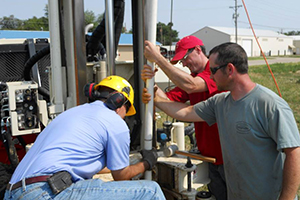
Jeramy Ashlock, assistant professor of civil, construction and environmental engineering, aims to improve the accuracy of geophysical soil profiling for seismic design and analysis.
The U.S. Geological Survey’s (USGS) Earthquake Hazards Program recently awarded Ashlock a $64,426 grant for the project, “Seismic Profiling by Multi-Mode Rayleigh Waves.”
Ashlock and geotechnical engineering doctoral student Shibin Lin will use the award to further develop the method using borehole geophones and probe-mounted sensors, which can detect Rayleigh waves, or vibrations, traveling through the soil due to impacts at the surface. The method can determine soil stiffness (shear-wave velocity) profiles to about 100 feet (30 meters) deep with sensors placed only 15-20 feet underground.

This test requires only one borehole at a site, while conventional invasive borehole tests require several boreholes to achieve high accuracy.
Compared to non-invasive surface wave geophysical tests, their work will enable more accurate and complete measurement of higher-modes of Rayleigh waves. The stiffness profiles from the tests are used to determine the site classification on an A through F scale (with A being hard rock and E and F being very soft soils), which is used in seismic hazard assessment and design of buildings and bridges.
They also will perform seismic cone-penetration tests, which will serve as a control to their hybrid surface-and-borehole tests.
Ashlock and Lin published the Geophysical Journal International article, “Multi-Mode Rayleigh Wave Profiling by Hybrid Surface and Downhole Methods,” regarding their preliminary work that led to the funded grant.
